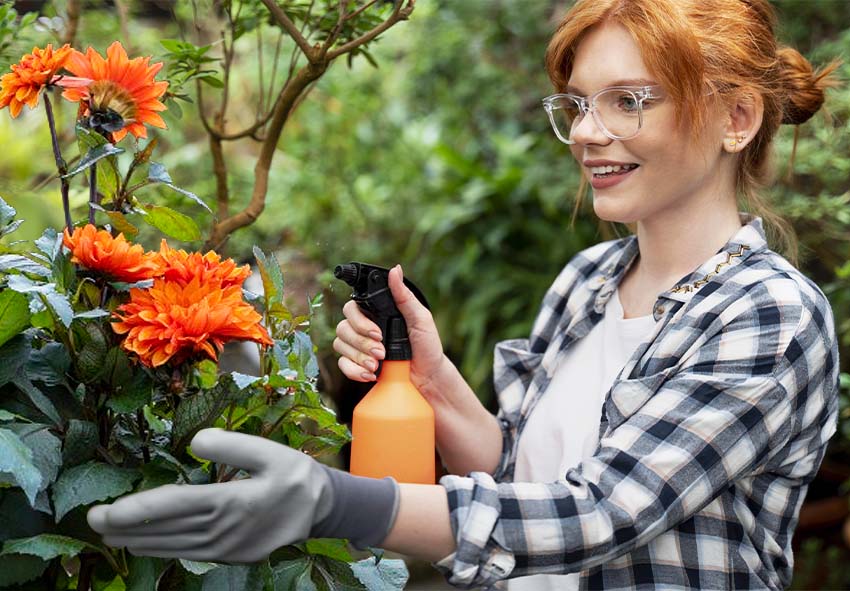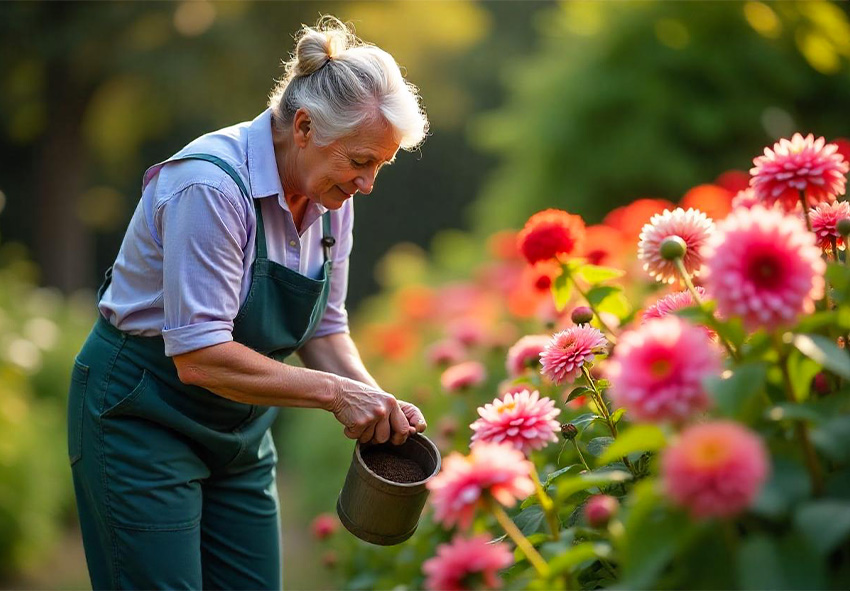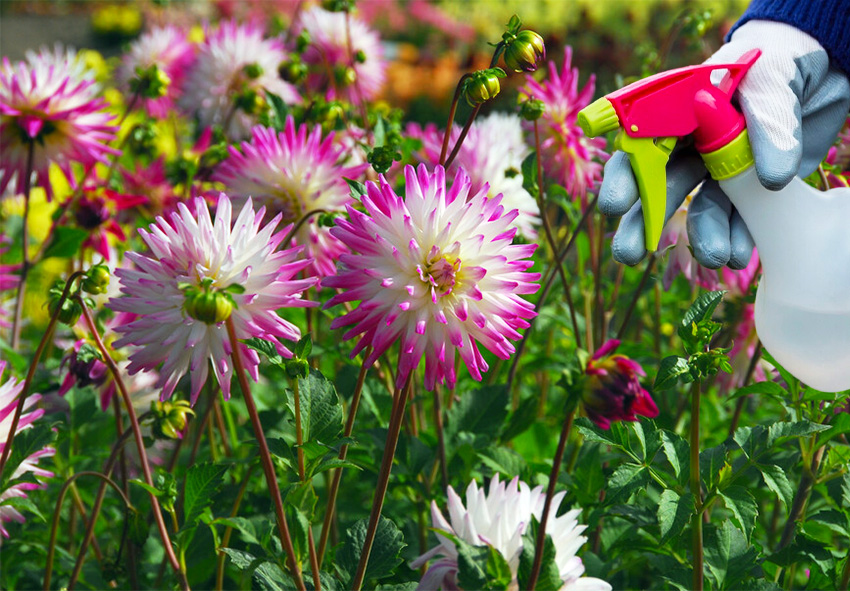Dahlias are among the most vibrant and rewarding flowering plants, but they are also prone to a variety of pests and diseases. Effective Dahlia pest control is essential to ensure these plants continue to produce lush blooms throughout the growing season. In this guide, you’ll learn how to identify, prevent, and treat the most common threats to your dahlias. Our gardening blog is a perfect place to find all the information you need!
Common Dahlia Pests to Watch Out For

Dahlias are highly attractive to a variety of garden pests that can quickly damage their leaves, stems, and blooms. Early identification of these insects is essential to prevent infestations from spreading. There are the most frequent pests that affect dahlias and how to manage them effectively.
- Aphids: small, soft-bodied insects that cluster on new dahlia growth, especially the undersides of leaves and flower buds. They suck sap from the plant, causing yellowing, curling, and stunted growth. Use neem oil or insecticidal soap to control infestations, and introduce natural predators like ladybugs for organic pest management.
- Slugs and Snails: slimy pests feed on young dahlia leaves, leaving behind large, irregular holes and shiny trails. Slugs and snails are most active at night or in damp conditions. Use copper barriers, diatomaceous earth, or beer traps to keep them under control without resorting to harsh chemicals.
- Spider Mites: thrive in hot, dry weather and are often found spinning fine webs on the undersides of leaves. They cause stippling and discoloration, leading to a dusty, unhealthy appearance. Hose off plants regularly and apply a miticide if necessary to reduce infestations.
- Earwigs and Caterpillars: chew through leaves and flower petals, often working overnight. Earwigs can be trapped using rolled-up newspaper or shallow dishes of oil. For caterpillars, remove them by hand or use a biological control like Bacillus thuringiensis (Bt) to protect your dahlias.
Most Common Dahlia Diseases
Like many ornamental plants, dahlias are vulnerable to several fungal, bacterial, and soil-borne diseases. These issues can weaken plants, reduce flowering, or even lead to plant loss if left untreated. Understanding common symptoms and causes is key to taking timely action.
Powdery Mildew
Powdery mildew appears as a white, powdery coating on dahlia leaves, especially during warm, humid conditions. It can distort growth and limit flower production. Improve airflow and apply organic fungicides to manage outbreaks effectively.
Botrytis (Gray Mold)
This fungal disease causes brown spots on leaves and flowers and thrives in cool, wet conditions. Remove affected plant parts and avoid overhead watering. Prune regularly to improve air circulation around the base of your plants.
Verticillium Wilt
A soil-borne fungus, verticillium wilt causes wilting, yellowing, and browning of leaves from the bottom up. It has no cure once established, so prevention through crop rotation and planting resistant varieties is essential. Avoid replanting dahlias in infected soil.
Bacterial Leaf Spot
This disease causes small, dark spots with yellow halos on the leaves, which can eventually lead to defoliation. It’s spread by splashing water and poor sanitation. Remove and dispose of infected leaves, and disinfect garden tools between uses.
Dahlia Disease Prevention Tips

Preventing disease is often easier and more effective than treating it after the fact. By creating the right growing environment, you can significantly reduce the chances of infections taking hold. These tips focus on soil health, watering practices, and spacing strategies to keep your dahlias disease-free.
Soil Preparation and Drainage
Healthy soil is the foundation of Dahlia disease prevention. Ensure your garden beds are well-drained and rich in organic matter. Consider raised beds if your soil is heavy or compacted, and always avoid planting in waterlogged areas.
Proper Spacing and Airflow
Crowded dahlias create a humid environment perfect for disease development. Space plants at least 18–24 inches apart depending on the variety. Prune the lower leaves and deadhead regularly to improve airflow and keep disease at bay.
Watering Practices
Water your dahlias at the base to keep the foliage dry, reducing fungal risk. Early morning watering allows excess moisture to evaporate during the day. Avoid overhead sprinklers, especially during cooler or humid periods.
Organic and Chemical Pest Control Options
There are multiple ways to protect dahlias from insect pests, ranging from gentle organic solutions to more targeted chemical treatments. Each method has its pros and cons depending on the severity of the issue. This section will help you choose the best approach for your garden’s needs.
Organic Pest Control for Dahlias
Organic methods are safer for pollinators and the environment. Use neem oil, insecticidal soap, and garlic or chili sprays as natural insect repellents. Companion planting with marigolds or basil can help deter common dahlia pests like aphids and beetles.
When to Use Chemical Treatments
Use chemical options only when organic methods fail or in severe infestations. Select targeted, low-toxicity products that are safe for ornamental plants. Always follow label instructions and apply during cooler parts of the day to minimize plant stress and protect beneficial insects. Use them in these cases:
- Severe or Widespread Infestations: When pests like aphids, spider mites, or caterpillars are affecting multiple plants and organic methods aren’t working, chemical treatments may be necessary for fast control.
- Fungal Outbreaks That Spread Quickly: Diseases like powdery mildew or botrytis can spread rapidly in humid conditions. Fungicides can help stop the disease before it destroys the plant.
- Repeated Failures with Organic Methods: If neem oil, insecticidal soap, or natural predators have failed to reduce pest populations, chemical options may offer a more effective solution.
- Protecting Valuable or Showcase Plants: When dealing with prize dahlias or plants used in shows or displays, chemical treatments can provide an added layer of protection during peak bloom periods.
- Late-Season Problems That Threaten Tuber Health: As the season ends, controlling pests and diseases is essential to ensure healthy tuber storage. Chemicals can help eliminate late-season threats before lifting the plants.
Seasonal Care for Disease-Free Dahlias

Proper seasonal care is essential for keeping dahlias strong, vibrant, and resistant to pests and diseases. Each stage of the growing season — spring, summer, and fall — requires different tasks to ensure optimal plant health. Learn what steps to take during each season to maximize your dahlias’ lifespan and bloom quality.
Spring Preparation
Before planting, inspect dahlia tubers for signs of rot or pests. Dust them with sulfur powder to prevent fungal infections and start them indoors if your growing season is short. Prepare your soil with compost or aged manure to boost nutrients.
Summer Monitoring
Summer is the prime season for both blooming and pest activity. Inspect your plants weekly for insects, webbing, or discolored leaves. Stake taller varieties to prevent wind damage and improve airflow around the plant.
Fall Clean-Up
At the end of the season, remove and discard all dead plant material to prevent overwintering pests. Dig up and clean tubers, allowing them to dry before storing in a cool, dark place. This reduces the risk of rot and reintroducing disease next season.
If you are looking for more detailed information about dahlia seasonal care tips, you can find it in our comprehensive guide for dahlias.
Common Mistakes to Avoid in Dahlia Care
Even with the best intentions, gardeners can make simple errors that compromise the health and performance of their dahlias. From planting mishaps to watering issues, these common mistakes can lead to poor growth, disease, or fewer blooms. Being aware of them in advance will help you grow stronger, more vibrant plants:
- Ignoring early pest signs like discolored leaves or sticky residue can allow infestations to escalate.
- Overcrowding plants limits airflow and encourages fungal diseases.
- Using the wrong fertilizer may cause lush foliage but few flowers — opt for low-nitrogen, bloom-focused formulas.
- Overwatering or poor drainage often leads to tuber rot and fungal issues.
- Neglecting to rotate crops can increase soil-borne disease pressure year after year.
Final Tips for Protecting Dahlias from Pests and Diseases
Consistent monitoring and timely action are your best defenses. Combine organic practices with preventative maintenance to build plant resilience. Always start with healthy stock and clean tools to reduce the chances of introducing pests or diseases into your garden.
Frequently Asked Questions (FAQs) about Dahlia Pests and Diseases
1. How often should I inspect my dahlias?
Check your plants at least once a week during the growing season. Look for pests, damaged leaves, or any signs of mold or wilting. Early detection makes treatment far more effective.
2. Can I reuse soil from diseased plants?
It’s not recommended. Soil that has hosted fungal or bacterial diseases may still harbor pathogens. Either solarize the soil before reuse or replace it entirely for a fresh start.
3. How can I order Holland dahlias from your online store?
Ordering Holland dahlias from our online store Dutch-bulbs.com is simple . Visit our website and browse our selection of dahlia varieties, including those sourced from Netherlands.
4. Do companion plants help deter pests on dahlias?
Yes, planting marigolds, garlic, or basil nearby can help deter common pests like aphids and beetles. These plants naturally repel insects and enhance biodiversity.
5. Is it safe to use mulch around dahlias?
Yes, but keep mulch a few inches away from the stems to avoid moisture buildup. Organic mulch like straw or bark can help retain moisture and suppress weeds.
Published: 13.05.2025
